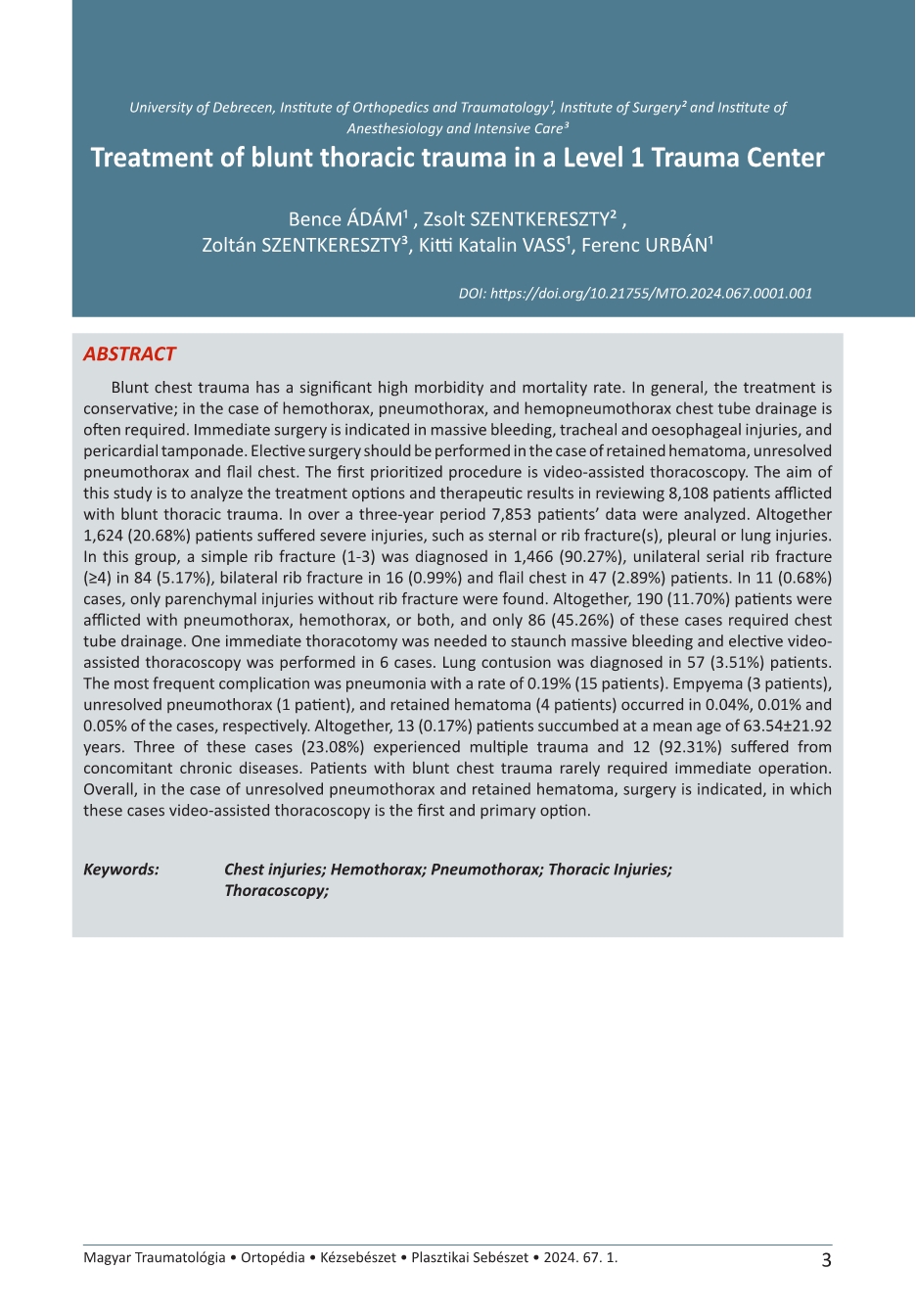Treatment of blunt thoracic trauma in a Level 1 Trauma Center
Abstract
Blunt chest trauma has a significant high morbidity and mortality rate. In general, the treatment is conservative; in the case of hemothorax, pneumothorax, and hemopneumothorax chest tube drainage is often required. Immediate surgery is indicated in massive bleeding, tracheal and oesophageal injuries, and pericardial tamponade. Elective surgery should be performed in the case of retained hematoma, unresolved pneumothorax and flail chest. The first prioritized procedure is video-assisted thoracoscopy. The aim of this study is to analyze the treatment options and therapeutic results in reviewing 8,108 patients afflicted with blunt thoracic trauma. In over a three-year period 7,853 patients’ data were analyzed. Altogether 1,624 (20.68%) patients suffered severe injuries, such as sternal or rib fracture(s), pleural or lung injuries. In this group, a simple rib fracture (1-3) was diagnosed in 1,466 (90.27%), unilateral serial rib fracture (≥4) in 84 (5.17%), bilateral rib fracture in 16 (0.99%) and flail chest in 47 (2.89%) patients. In 11 (0.68%) cases, only parenchymal injuries without rib fracture were found. Altogether, 190 (11.70%) patients were afflicted with pneumothorax, hemothorax, or both, and only 86 (45.26%) of these cases required chest tube drainage. One immediate thoracotomy was needed to staunch massive bleeding and elective video-assisted thoracoscopy was performed in 6 cases. Lung contusion was diagnosed in 57 (3.51%) patients. The most frequent complication was pneumonia with a rate of 0.19% (15 patients). Empyema (3 patients), unresolved pneumothorax (1 patient), and retained hematoma (4 patients) occurred in 0.04%, 0.01% and 0.05% of the cases, respectively. Altogether, 13 (0.17%) patients succumbed at a mean age of 63.54±21.92 years. Three of these cases (23.08%) experienced multiple trauma and 12 (92.31%) suffered from concomitant chronic diseases. Patients with blunt chest trauma rarely required immediate operation. Overall, in the case of unresolved pneumothorax and retained hematoma, surgery is indicated, in which these cases video-assisted thoracoscopy is the first and primary option.
References
Broderick SR: Hemothorax: Etiology, diagnosis, and management. Thorac Surg Clin. 2013. 23. (1): 89-96. https://doi.org/10.1016/j.thorsurg.2012.10.003
Çakmak M, Nail Kandemir M: Study of 433 operated cases of thoracic trauma. Indian J Surg. 2016. 78. (6): 477-481. https://doi.org/10.1007/s12262-015-1414-5
Dennis BM, Bellister SA, Guillamondegui OD: Thoracic trauma. Surg Clin North Am. 2017. 97. (5): 1047-1064. https://doi.org/10.1016/j.suc.2017.06.009
Dogrul BN, Kiliccalan I, Asci ES, Peker SC: Blunt trauma related chest wall and pulmonary injuries: An overview. Chin J Traumatol. 2020. 23. (3): 125-138. https://doi.org/10.1016/j.cjtee.2020.04.003
DuBose J, Inaba K, Okoye O, Demetriades D, Scalea T, O'Connor J, Menaker J, Morales C, Shiflett T, Brown C, Copwood B; AAST Retained Hemothorax Study Group: Development of posttraumatic empyema in patients with retained hemothorax: results of a prospective, observational AAST study. J Trauma Acute Care Surg. 2012. 73. (3): 752-757. https://doi.org/10.1097/TA.0b013e31825c1616
Getz P, Mommsen P, Clausen JD, Winkelmann M: Limited influence of flail chest in patients with blunt thoracic trauma – A matched-pair analysis. In Vivo 2019. 33. (1): 133-139. https://doi.org/10.21873/invivo.11449
Huang FD, Yeh WB, Chen SS, Liu YY, Lu IY, Chou YP, Wu TC: Early management of retained hemothorax in blunt head and chest trauma. World J Surg. 2018. 42. (7): 2061-2066. https://doi.org/10.1007/s00268-017-4420-x
Jones CW, Rodriguez RD, Griffin RL, McGwin G, Jansen JO, Kerby JD, Bosarge PL: Complications associated with placement of chest tubes: A trauma system perspective. J Surg Res. 2019. 239: 98-102. https://doi.org/10.1016/j.jss.2019.01.012
Lin HL, Tarng YW, Wu TH, Huang FD, Huang WY, Chou YP: The advantages of adding rib fixations during VATS for retained hemothorax in serious blunt chest trauma - A prospective cohort study. Int J Surg. 2019. 65: 13-18. https://doi.org/10.1016/j.ijsu.2019.02.022
Lodhia JV, Konstantinidis K, Papagiannopoulos K: Video-assisted thoracoscopic surgery in trauma: pros and cons. J Thorac Dis. 2019. 11. (4): 1662-1667. https://doi.org/10.21037/jtd.2019.03.55
Lovisari F, Favarato M, Giovannini I, Giudici R, Fumagalli R: Chest wall pain management after chest wall trauma. J Vis Surg. 2020. 6: 18. https://doi.org/10.21037/jovs.2019.11.01
Ludwig C, Koryllos A: Management of chest trauma. J Thorac Dis. 2017. 9. (3): 172-177. https://doi.org/10.21037/jtd.2017.03.52
Manlulu AV, Lee TW, Thung KH, Wong R, Yim AP: Current indications and results of VATS in the evaluation and management of hemodynamically stable thoracic injuries. Eur J Cardiothorac Surg. 2004. 25. (6): 1048-1053. https://doi.org/10.1016/j.ejcts.2004.02.017
Marro A, Chan V, Haas B, Ditkofsky N: Blunt chest trauma: Classification and management. Emerg Radiol. 2019. 26. (5): 557–566. https://doi.org/10.1007/s10140-019-01705-z
Martínez Casas I, Amador Marchante MA, Paduraru M, Fabregues Olea AI, Nolasco A, Medina JC: Thorax trauma severity score: Is it reliable for patient's evaluation in a secondary level hospital? Bull Emerg Trauma. 2016. 4. (3): 150-155.
Molnar TF: Thoracic trauma: Which chest tube when and where? Thorac Surg Clin. 2017. 27. (1): 13-23. https://doi.org/10.1016/j.thorsurg.2016.08.003
Phillips B, Shaw J, Turco L, McDonald D, Carey J, Balters M, Wagner M, Bertellotti R, Cornell DL, Agrawal DK, Asensio JA: Traumatic pulmonary pseudocyst: An underreported entity. Injury. 2017. 48. (2): 214-220. https://doi.org/10.1016/j.injury.2016.12.006
Požgain Z, Kristek D, Lovrić I, Kondža G, Jelavić M, Kocur J, Danilović M: Pulmonary contusions after blunt chest trauma: clinical significance and evaluation of patient management. Eur J Trauma Emerg Surg. 2018. 44. (5): 773-777. https://doi.org/10.1007/s00068-017-0876-5
Sanna S, Bertolaccini L, Brandolini J, Argnani D, Mengozzi M, Pardolesi A, Solli P: Uniportal video-assisted thoracoscopic surgery in hemothorax. J Vis Surg. 2017. 14. (3): 126. https://doi.org/10.21037/jovs.2017.08.06
Staub LJ, Biscaro RRM, Kaszubowski E, Maurici R.: Chest ultrasonography for the emergency diagnosis of traumatic pneumothorax and haemothorax: A systematic review and meta-analysis. Injury. 2018. 49. (3): 457-466. https://doi.org/10.1016/j.injury.2018.01.033
Zeiler J., Idell S., Norwood S., Cook A.: Hemothorax: A Review of the Literature. Clin Pulm Med. 2020. 27. (1): 1-12. https://doi.org/10.1097/CPM.0000000000000343
Ziapour B, Mostafidi E, Sadeghi-Bazargani H, Kabir A, Okereke I: Timing to perform VATS for traumatic-retained hemothorax (a systematic review and meta-analysis). Eur J Trauma Emerg Surg. 2020. 46. (2): 337-346. https://doi.org/10.1007/s00068-019-01275-2
Zreik NH, Francis I, Ray A, Rogers BA, Ricketts DM: Blunt chest trauma: bony injury in the thorax. Br J Hosp Med (Lond). 2016. 77. (2): 72-77. https://doi.org/10.12968/hmed.2016.77.2.72
Zreik NH, Francis I, Ray A, Rogers BA, Ricketts DM: Blunt chest trauma: soft tissue injury in the thorax. Br J Hosp Med (Lond). 2016. 77. (2): 78-83. https://doi.org/10.12968/hmed.2016.77.2.78











